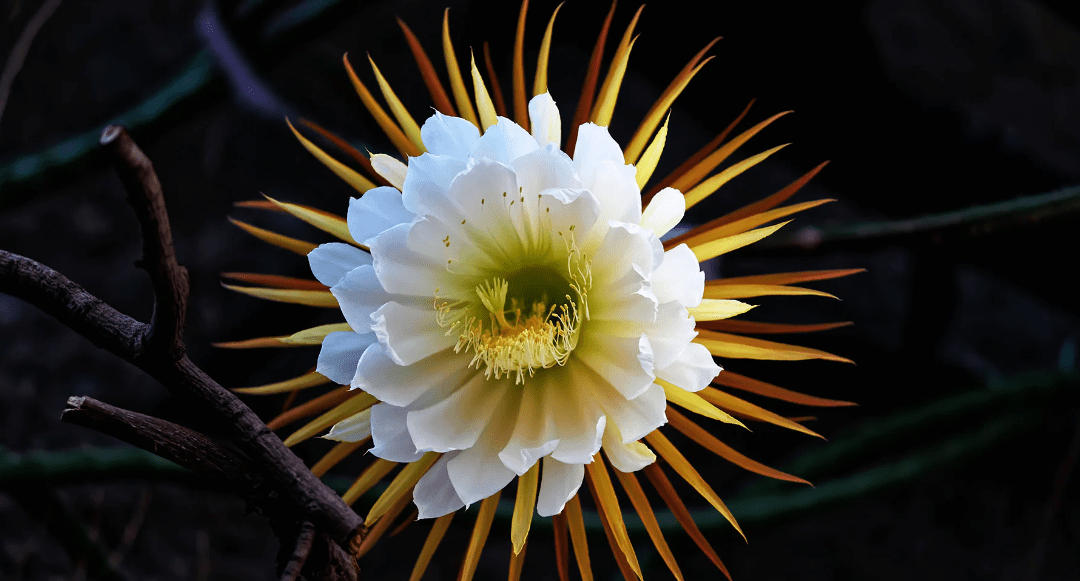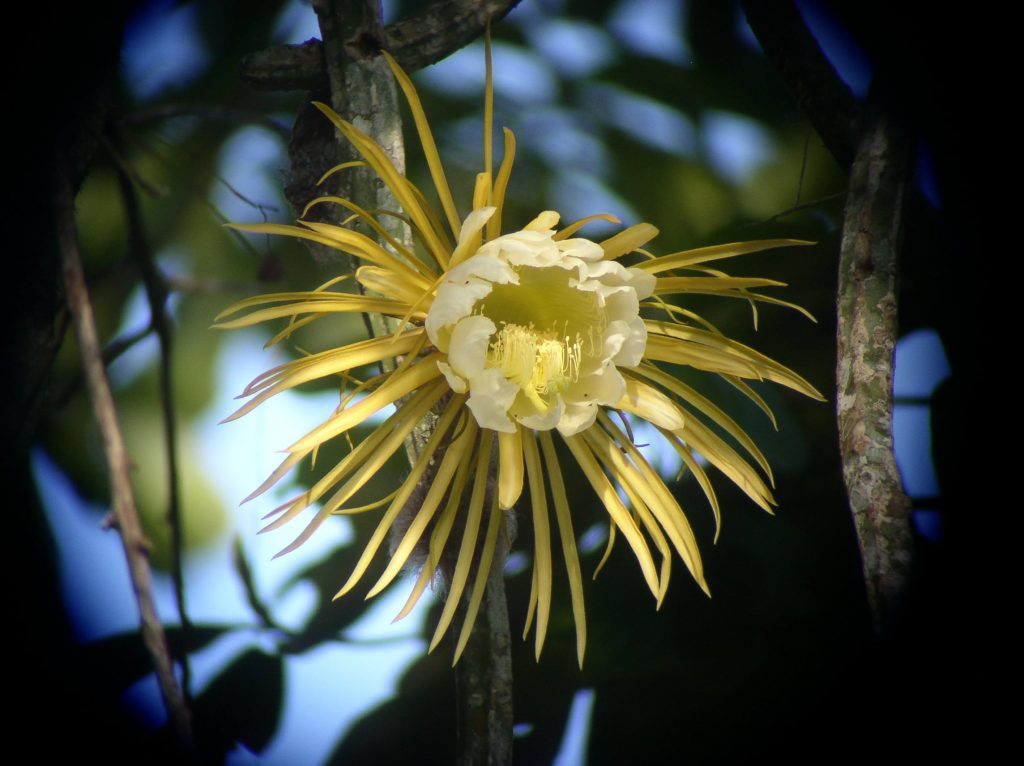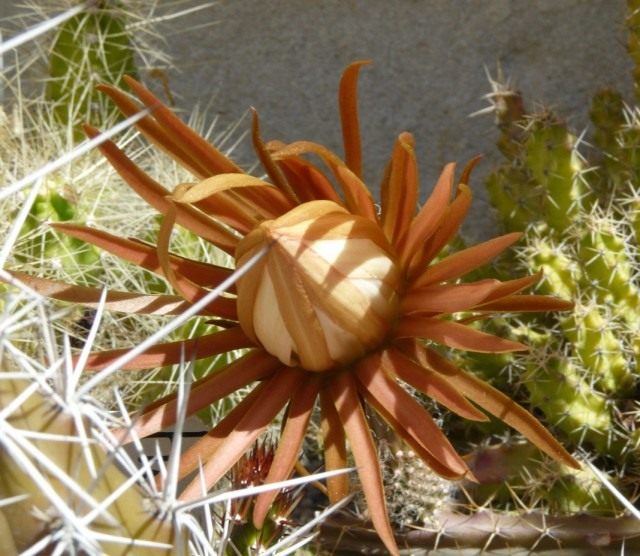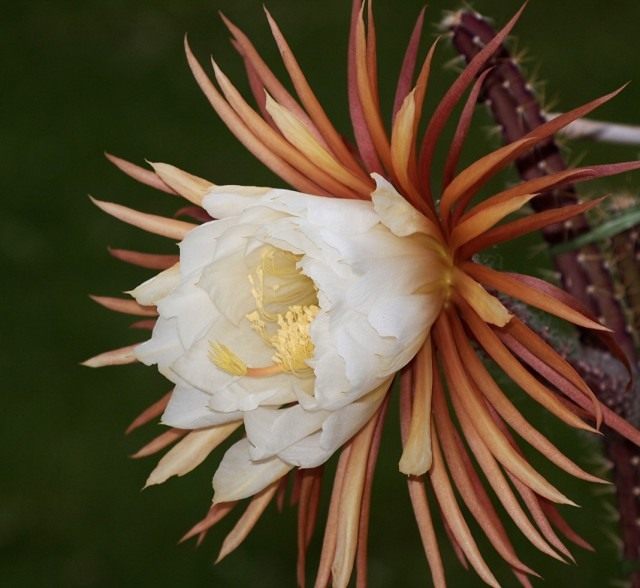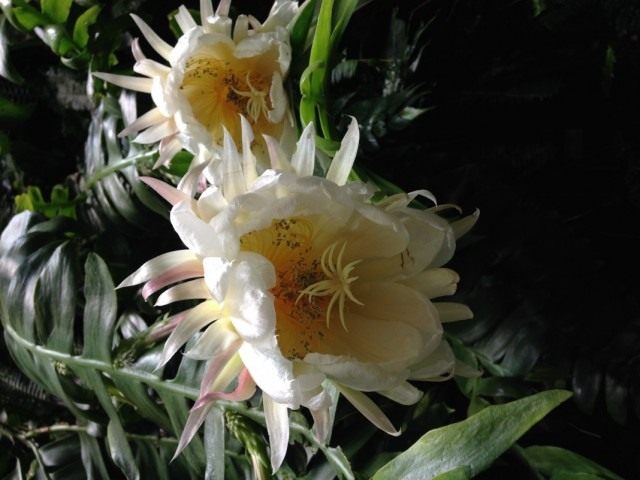The fragrant flowers of selenicereus cannot be called anything other than magnificent and impressive. It is no accident that this unique cactus with almost smooth shoots became famous under the name “queen of the night cactus” Even compared to other beautifully flowering representatives of the Cactus family, Selenicereus is considered a unique plant.
The fabulous beauty of flowering and the original strong aroma is forcing an increasing number of flower growers to choose the queen of the night as their favorite exotic.
Although the huge flowers bloom for only one night, and it is very difficult to place a cactus with shoots several meters long, Selenicereus is worth all the effort spent on achieving such spectacular flowering. Caring for it is not so difficult, it is much more difficult to create optimal conditions for it.
Table of Contents
Queen of the night Flower: A nighttime Spectacle
The Queen of the Night cactus can rightfully be considered a unique of its kind. The genus of these rare exotic beauties includes creeping cacti of impressive size, which are rightfully ranked among the most spectacular beautifully flowering indoor crops “for the elite.”
Its popular names – lunar cereus, lunar cactus, princess of the night, moon candle, or queen of the night cactus – in one way or another appeal to the presence of Selene, the Greek goddess of the Moon, in the species name.
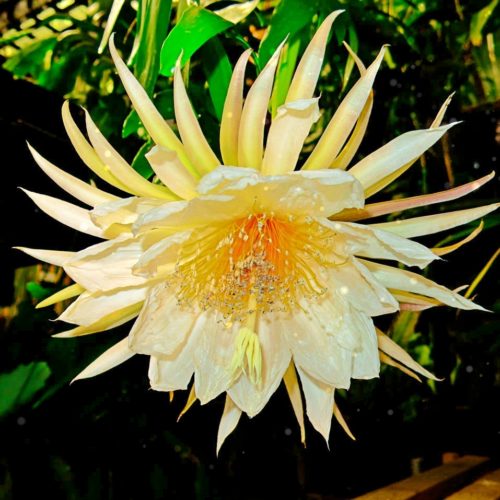
Thousands of tourists from all over the world come to see the flowering of Selenicereus grandiflorus in botanical gardens every year, and the institutions themselves especially extend their work at night so that the greenhouses can be visited by as many spectators as possible.
Selenicereus largely owes its status as a “cactus not for everyone” to the special attitude towards the plant in botanical collections. But the magnificent queen of the night cactus can be grown independently along with other types of beautifully flowering cacti.
Queen of the Night Cactus combines 25 species of unusual forest cacti into one genus. These are large epiphytes with powerful, long, and fragile shoots, most often flat, extending from the base of the bush.
These cacti differ in appearance from both disocacti and other types of hanging succulents. Reaching only 1-2 cm in diameter, and not even limited to 5 meters in length, the shoots of this cactus are impressive at first sight. Their surface is almost completely bare, with a glossy sheen.
The spines are located sparsely in the areoles, small, and thin, they, however, are distinguished by increased tenacity. The flowers match the unusually long shoots and are striking in size.
The inflorescences of the Queen of the Night Cactus cannot be called anything other than huge, and complex in structure. Outwardly, they somewhat resemble a water lily; in fact, they are complex tubular inflorescences with numerous perianths, divided into hundreds of internal and external petal lobes. In this case, the inner petals can either form a cup or fill the inner space of the flower, like chrysanthemums.
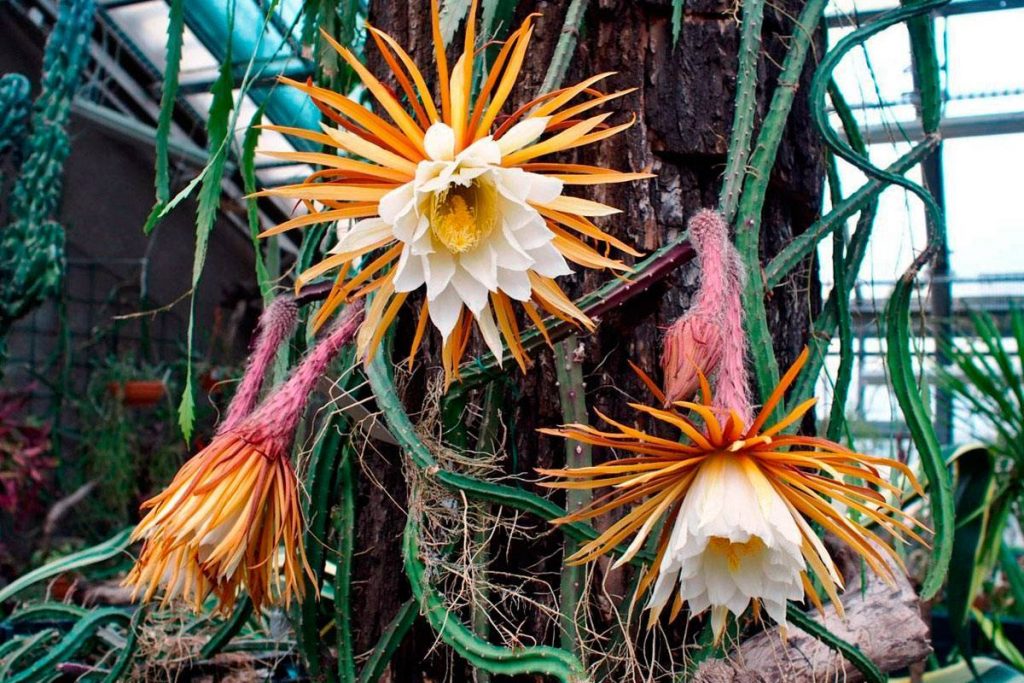
The needle- or thread-like outer lobes highlight the calyx from the wider, tongue-like perianth lobes, creating the impression of a double structure of the flower.
It is worth taking a closer look at the buds of Queen of the Night Cactus. At the beginning of their development, they seem to be a dense ball of white hairs, from which a candle-shaped dense bud gradually rises. They are decorated with flowers and luxurious lush stamens.
Popular types
Tropical cacti from the genus Selenicereus in indoor culture are represented either by hybrid plants or by one of the 5 most common species.
These cacti, American in origin, boast considerable diversity, although the name “Queen of the Night Cactus” is usually associated with the name of one single species – Selenicereus grandiflora.
Selenicereus grandiflorus
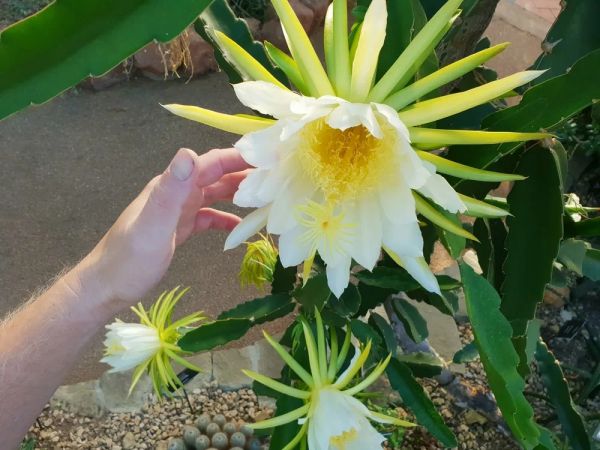
Queen of the Night Cactus is not at all the most spectacular representative of the genus in terms of the beauty of its flowers, and its inflorescences are far from the largest.
But the queen of the night cactus became famous as one of the first Selenicereus introduced into indoor culture and certainly as one of the most reliable species. Plants produce rather specific long shoots, which do not always look very decorative.
The greenery of the Queen of the Night Cactus must be tied to supports; already at a young age, it forms many chaotically located, straight-growing, drooping, climbing shoots up to 5 m long and 1 to 3 cm in diameter, often densely branching and forming peculiar tangles.
On the shoots, 3-4 ribs are visible, and the areoles of small spines are sparsely located and fall off over time. This cactus produces aerial roots that help the plant cling to supports.
The greenish-gray color, sometimes with a stormy tint, and glossy shine emphasize the thinness of the shoots. But if the greenery of the plant cannot boast of extreme decorativeness, then the beautiful large flowers that bloom at night are truly impressive.
Single, white-colored, they reach a diameter and length of up to 30 cm, bloom only at dusk, and last only a few hours until morning arrives.
Thin, needle-shaped, numerous perianth lobes form a kind of halo around the inner funnel of the flower with lingual “petals”. The outer petals are narrow and long, the inner ones are much wider and shorter. The golden yellow color of the edge petals only emphasizes the shining white center of the flower.
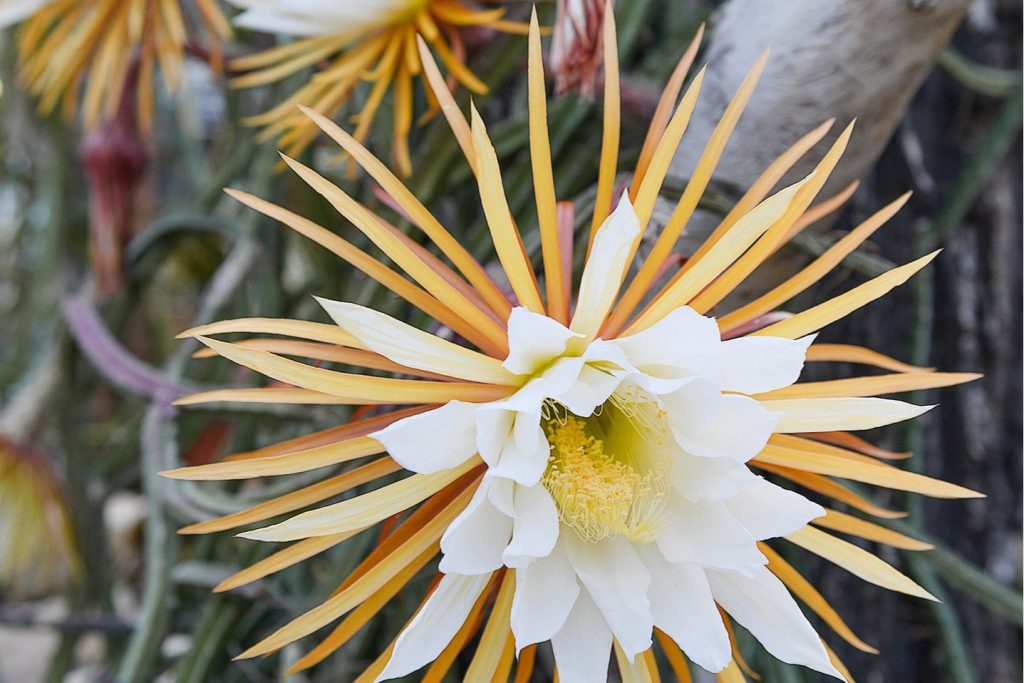
One of the advantages of the Queen of the Night cactus is the formation of a large number of buds, the flowers of which bloom one after another in spring and early summer. Among the distinctive features of the large-flowered Selenicereus is the delicate aroma of vanilla with light notes of jasmine, which is surprisingly strong in the night air.
After flowering, the Queen of the Night cactus produces large spherical fruits up to 9 cm in length in yellow, orange, red, and pink colors.
Selenicereus pteranthus
It is only slightly inferior in popularity to the most common species. It is also a fairly large plant with shoots reaching several meters, ribbed, creeping, and powerful. The flowers have a slightly different, “airy” structure and a complete lack of aroma.
Even less commonly found in indoor culture:
Selenicereus hamatus

It is capable of producing lashes of shoots up to 12 m in length, a cactus with a bright green color, numerous ribs, peculiar hook-shaped processes, and spiny bristles. Its inflorescences reach 40 cm in length and 20 cm in diameter and are distinguished by fairly wide outer and almost oval inner perianth lobes.
The flowers of this species are more reminiscent of cups, distinguished by pale yellow stamens and a pale light green color.
Selenicereus anthonyanus
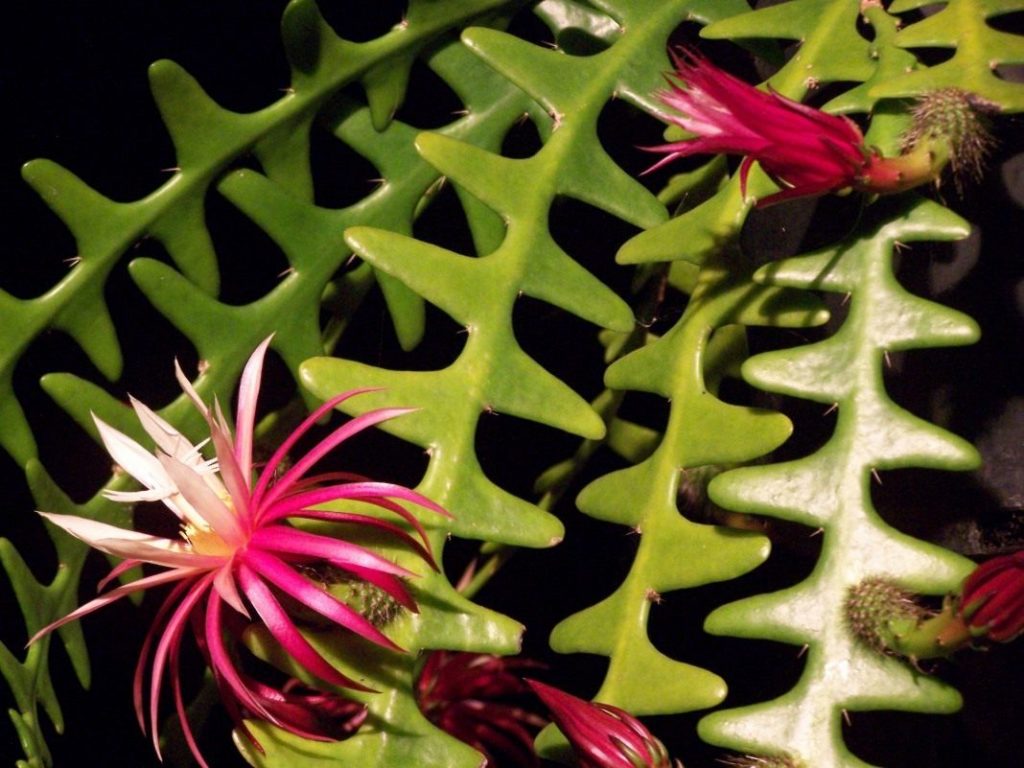
It is also famous for its common name “fishbone”. This climbing cactus with delightful leaf-shaped, fleshy stems up to 15 cm wide and several meters long truly resembles fish skeletons in the shape of its shoots.
Flat stems with a fairly bright color are deeply dissected at the edges like oak or dandelion leaves, but the leaf lobes are not arranged in pairs, and the short spines in the areoles are almost invisible. The flowers of this cactus are surprisingly elegant and have a brighter color than those of their competitors.
Even though they reach a diameter of only 20 cm, and a length of only 12 cm, the transition of the color of the perianth from bright pink on the outside to orange in the center and delicate creamy pink inside the corolla seems surprisingly watercolor.
The outer and inner perianths are almost identical in width and differ only in the greater length of the outer petals. In this Selenicereus, the perianth evenly fills the flower calyx, slightly reminiscent of garden dahlias and chrysanthemums. This species is often grown in hanging culture.
Selenicereus golden-flowered

Selenicereus Golden Heart ( Selenicereus chrysocardium ), on its dense shoots reaching several meters in length, flaunts not even depressions and depressions, but leaf-shaped blades reaching 15 cm in length and 4 cm in width.
From a distance, its shoots appear to be feathery leaves, and only up close it is noticeable that it is just a flattened succulent stem.
The flowers of this species are large, funnel-shaped, up to 25 cm in diameter, very fragrant, with a creamy-reddish tint of the outer and snow-white color of the inner perianth petals. The most striking part of the plant is the deep yellow stamens, which look like a golden center.
Caring for the Queen of the Night Cactus at home
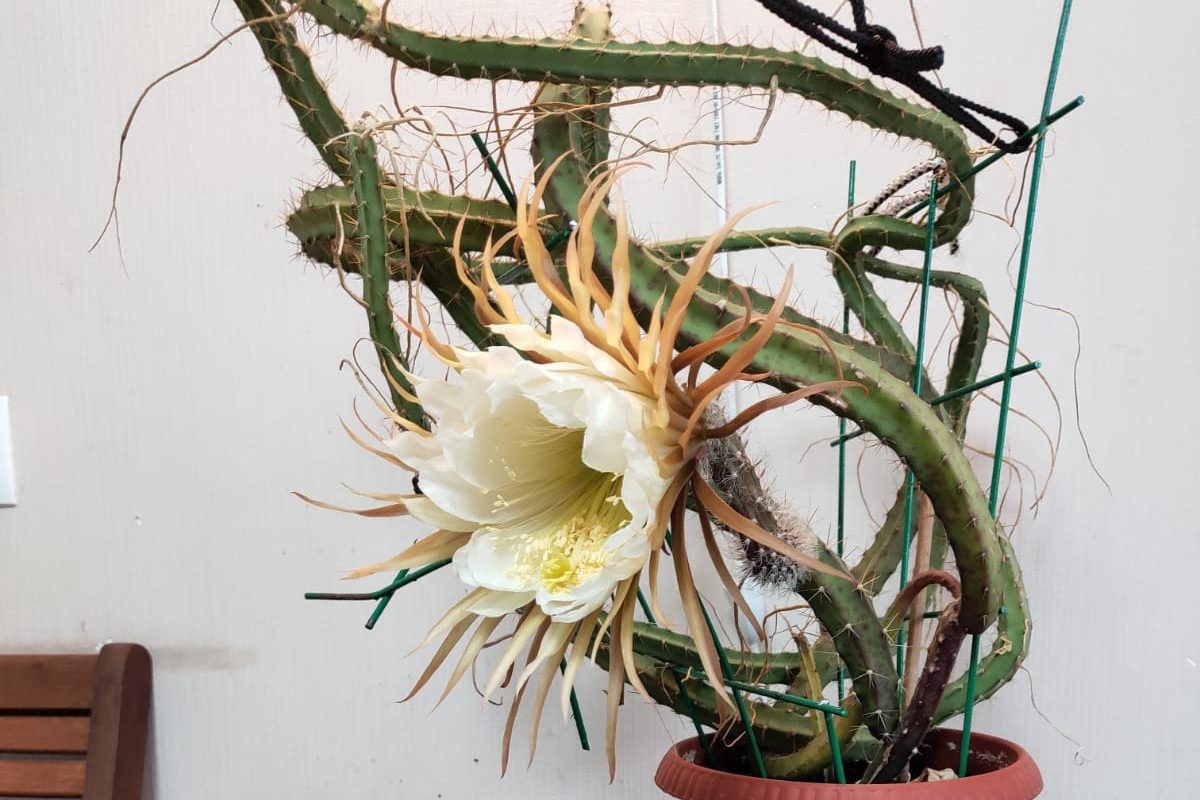
You don’t often see the Queen of the Night cactus in the collections of even big cacti lovers. Low popularity and extremely low distribution at home are associated, first of all, with those myths that turn the plant almost exclusively into a greenhouse crop.
The Queen of the Night cactus is no more difficult to grow than any other flowering cactus that requires a cool winter. It is quite easy to choose the conditions for it, and attentive care is no different from the care that needs to be provided to any beautifully flowering plant in the house.
Moreover, the Queen of the Night cactus is quite unpretentious, develops quickly, and pleasantly pleases with abundant flowers, which fully compensate for the difficulties of creating the correct dormancy regime.
Lighting
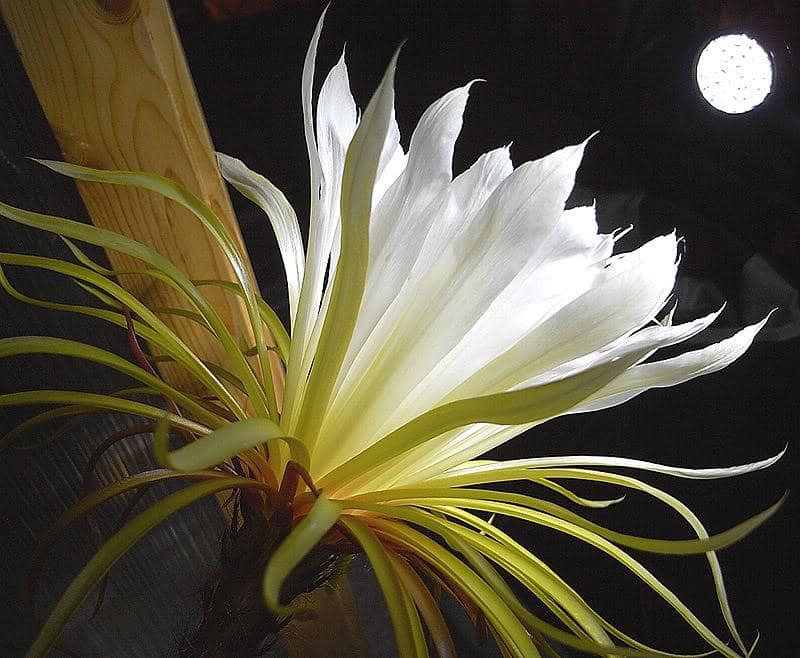
The Queen of the Night cactus can be considered not just one of the most light-loving indoor plants, but also one of the sun-loving crops. This cactus can be displayed on south-facing windowsills; it is not afraid of direct sunlight and blooms much better in a sunny place.
Even midday rays do not affect the attractiveness of the plant. True, at the stage of active development, Queen of the Night cactus can put up with both partial shade and diffuse lighting: the cactus retains its love for the sun, but bright lighting becomes vital not at the stage of active development, but during the resting phase.
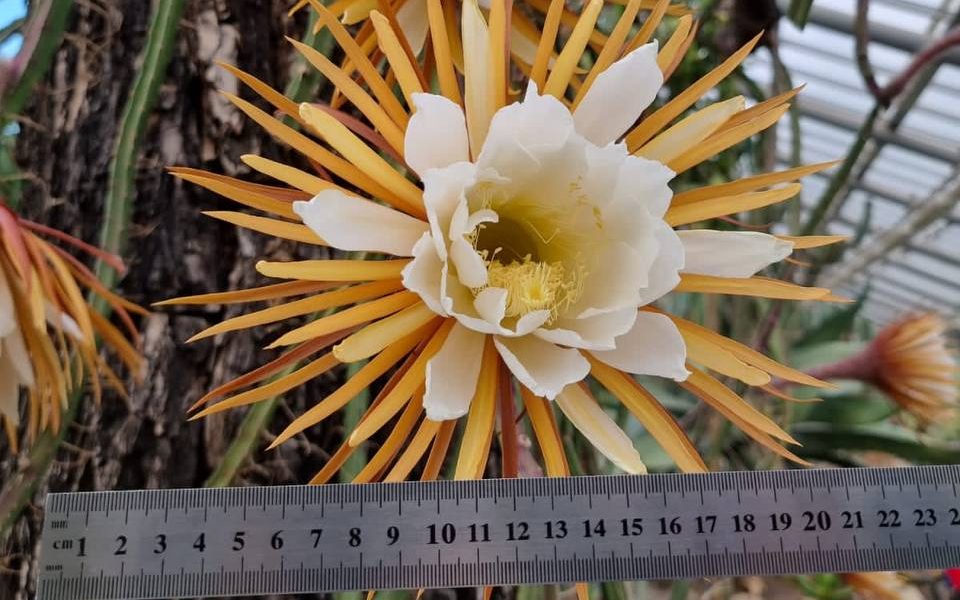
Providing a sunny location is one of the important conditions for stimulating flowering in this cactus; it is necessary for the development of a large number of strong buds. Queen of the Night cactus does not like artificial lighting and does not respond very well to even slight fluctuations in lighting during the flowering or dormant stage.
Temperature
During the winter, Queen of the Night cactus should be kept in cool conditions. The air temperature should not fall below 5 degrees, while the optimal temperature range is 10-12 degrees. The maximum temperature allowed during the resting stage is 18 degrees, but it is best if it stays as close to 10 degrees as possible.
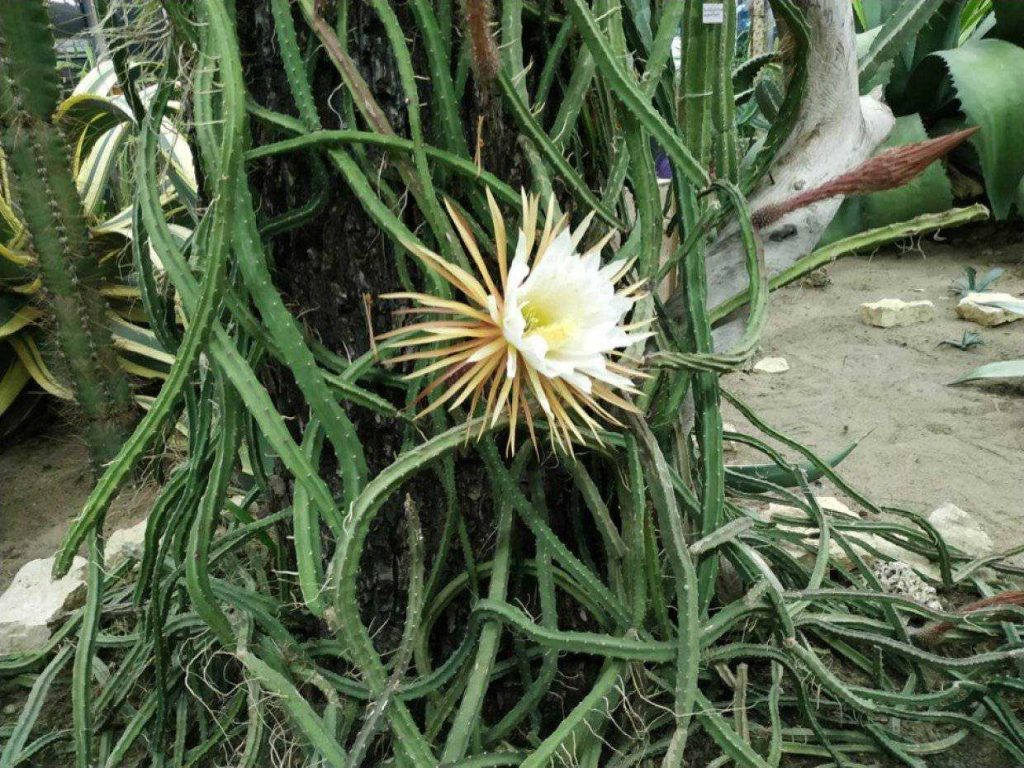
During the period of active growth, this cactus can only grow at room temperature. Cool conditions at the stage of budding and flowering are unacceptable; it is better to place cacti in hot conditions, since in fact during flowering they are heat-dependent and, due to violation of the comfortable temperature range, the buds may fall off. During spring and summer, any temperature from 18 to 25 degrees or hotter is suitable for Selenicereus.
One of the features of the Queen of the Night cactus with long and chaotically growing shoots can be safely called intolerance to drafts and sudden temperature fluctuations.
True, drafts can cause particular harm to a plant only at the stage of budding and flowering, during which a temperature difference of more than 3-4 degrees can cause a massive shedding of buds and even flowers beginning to bloom.
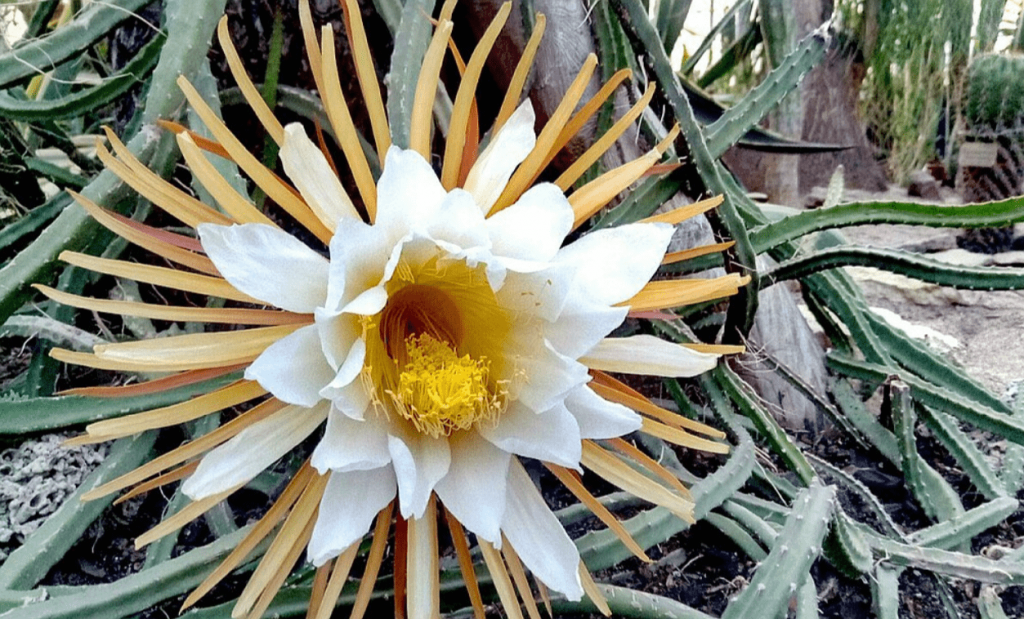
The Queen of the Night cactus should be placed in places protected from any air fluctuations, especially from cold air currents. But this cactus grows well under artificial heating (though if there is no contrast between the draft and the air from the radiators).
In summer, The Queen of the Night cactus can be placed on protected balconies. As a result of brighter lighting, the shoots will acquire a reddish tint, but then quickly restore their natural color. But next year the cactus will bloom more abundantly.
Watering and air humidity
To find the optimal watering strategy for the Queen of the Night cactus, you must always check the condition of the soil, monitoring the degree of drying out. When carrying out each subsequent procedure, you must make sure that the substrate is completely dry in the top layer and partially dry in the middle.
This cactus, like most of its beautifully flowering brethren, is extremely afraid of waterlogging. Any excessive or too frequent watering can lead not only to rotting but also to the death of the plant.

During the winter, The Queen of the Night cactus must be kept in near-dry conditions to stimulate flowering; it is watered very rarely, just to prevent the shoots from withering. But in spring and summer, when carrying out such procedures, they are always guided precisely by the rate of drying of the substrate.
This cactus belongs to those types of indoor plants that do not tolerate hard water very well. For it, you can either select settled soft water or especially soften the usual one by adding any natural acid. But it is important not to overdo it with acidification.
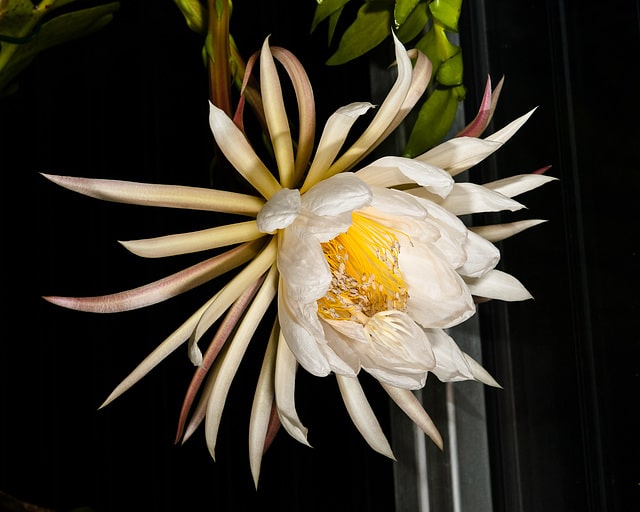
In general, the Queen of the Night cactus feels great under normal conditions and does not need air humidification procedures. For the luxurious flowering of this plant, it is necessary to ensure sufficient air humidity.
This cactus, unlike its fellows, simply loves regular spraying and even foliar fertilizers. At the same time, increased humidity is important for Selenicereus only during the period of flowering budding, while in winter any increase in air humidity can lead to problems with rot and lack of flowering.
To remove dust, you can use rinsing or washing methods. At the same time, when spraying, when watering, and when removing dust, it is very important to monitor the water temperature, which should be equal to the air temperature or be slightly higher.
Ferlizer
The actively growing, very large shoots of the Queen of the Night cactus necessitate the need for somewhat more active feeding than for other members of the family.
Selenicereus is fed not once a month, but once every 10-14 days. Fertilizer is applied only during the active development stage from March to November, completely abandoning procedures during the dormant stage.
For this cactus, special mixtures of fertilizers intended for representatives of the Cactus family are best suited.

In addition to root feeding, the Queen of the Night cactus loves foliar treatment with a weakly concentrated aqueous solution of fertilizers. At the same time, during budding and flowering, spraying with fertilizers can be done more frequently than the manufacturer recommends.
Pruning and formation
The formation of the Queen of the Night cactus is by far the most difficult aspect of growing them.
Randomly growing stems, sometimes densely branching, scattering in different directions, hanging, and large, but at the same time, like all cacti, afraid of injury, create problems with the placement of the plant.
Selenicereus requires constant shaping and careful attention to tying. The work is always complicated by very tenacious, albeit small, sparsely located thorns.

Supports are always installed for Selenicereus cactus. Since the plant itself does not have an impressive appearance, it is through the supports that it can be made more decorative. If you use ordinary pegs or boring supports, you can make the cactus even more unremarkable.
In addition to tying it to a support, selenicereus will also need pruning of unattractive or long shoots. Full formation is not carried out, since it does not contribute to thickening or creating more beautiful bushes.
Therefore, pruning should only be done when the cactus needs it (or is advisable from the point of view of ease of handling the plant). After damage, the Queen of the Night cactus grows back quite well. But it is better to cut only no more than 3 shoots at a time since more severe pruning will cause the formation of unsightly stumps.
If during transplantation, the shoots are accidentally injured, it is necessary to cut the stem as quickly as possible just below the site of damage.
Transplantation and substrate
Unlike most cacti, Queen of the Night cactus prefers a fairly nutritious, humus-rich substrate. But with all the importance of nutritional value, one should not forget about the two most important soil parameters – water and air permeability.
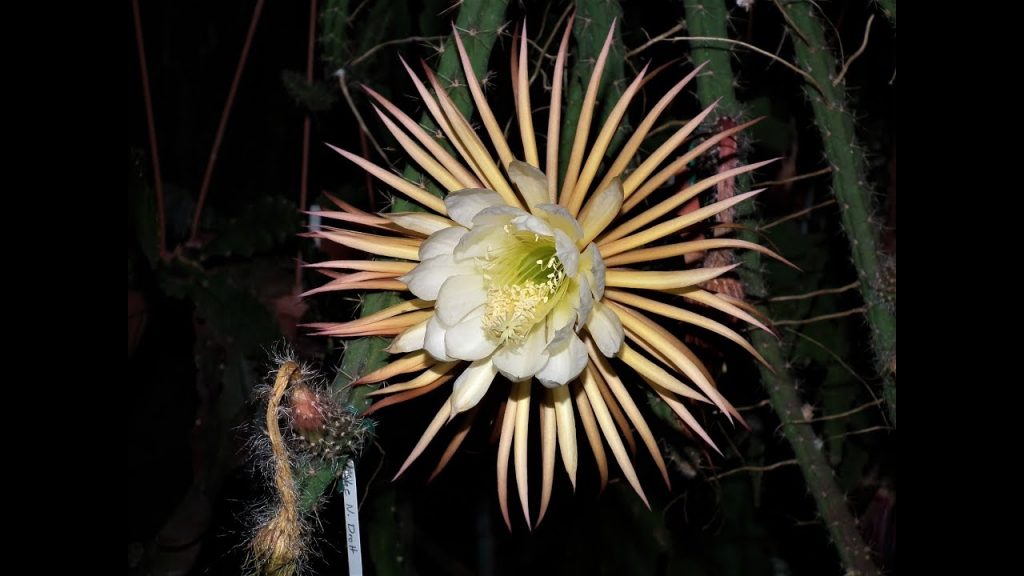
For this cactus, you can use any ready-made mixture for succulents and cacti. But to achieve a better degree of drainage, it is advisable to add charcoal, fine expanded clay, vermiculite, or agro perlite to it. You can create a substrate yourself by mixing turf soil with coarse sand in a 2:1 ratio with the same loosening additives.
Replanting a plant causes difficulties only in terms of handling large and “inconvenient” shoots. Young cacti are replanted annually, adults – only as necessary and possible.
The optimal time for transplantation is considered to be mid-spring. During the procedure, it is necessary to lay high, powerful drainage at the bottom of the container.

In years when replanting is not carried out, for Selenicereus, the top layer of soil is completely removed to the level of the beginning of the root system and replaced with fresh substrate.
Diseases and pests
Among the pests, the greatest concern for the Queen of the Night cactus is mainly felt insects, scale insects, and spider mites, which are very difficult to control on cacti. The only acceptable method of control is the use of a highly targeted fungicide.
Due to waterlogging of the stems and base of the bush, various rots spread very actively. They need to be dealt with by correcting care and timely pruning of damaged parts.
Among the queens of the night, various types of specific spotting are also common, which are usually characteristic only of hybrid plants. It is advisable to combat them with fungicides, although these diseases can be very difficult to overcome.
Reproduction
Cuttings are considered the optimal propagation method for the Queen of the Night cactus. Since the plants produce long shoots, they can be easily cut into small fragments and, after drying the sections, rooted (in any slightly moist substrate or under a hood in humid air).
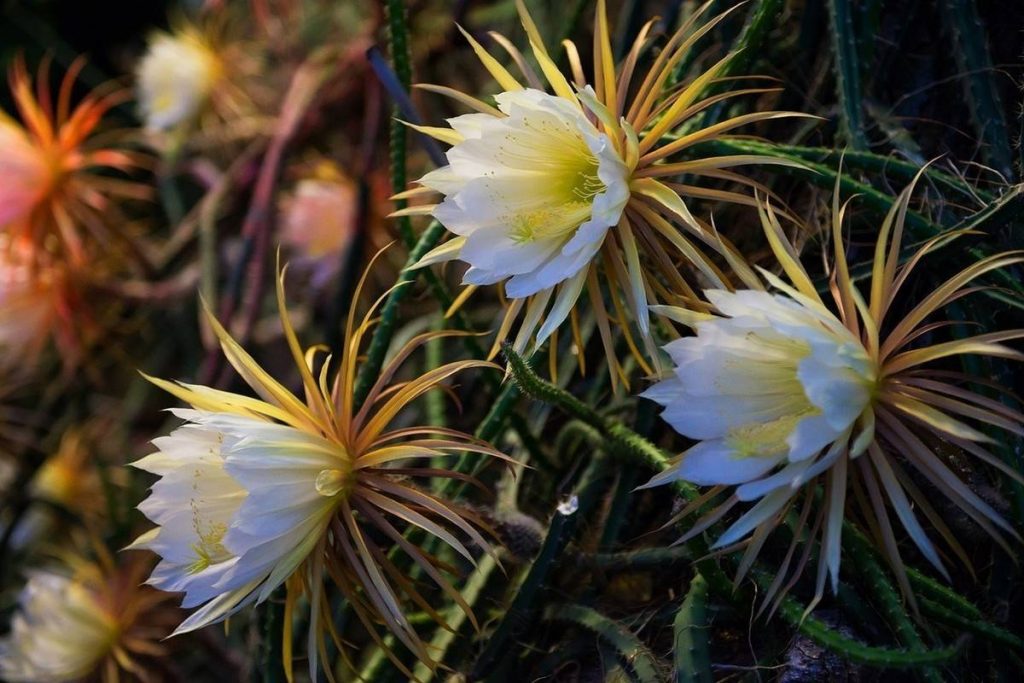
The best time for cuttings is spring. The younger the shoot, the faster and better it will take root.
You can also get the Queen of the Night cactus from seeds, however, under room conditions, they rarely ripen completely but are sometimes found on sale.
Seeds easily germinate in slightly moistened soil, provided they are not buried too deeply, covered with film or glass, and kept at room temperature.
Young selenicereus obtained by any method develop very actively, increase the length of shoots by several meters per year, and are capable of producing buds by the fifth year.

